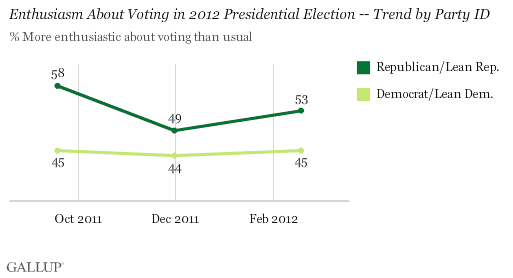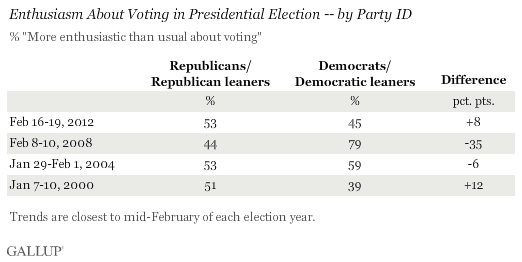PRINCETON, NJ -- By 53% to 45%, Republicans, including independents who lean Republican, are slightly more likely than Democrats and Democratic leaners to say they are "more enthusiastic than usual about voting" this year. Republicans have consistently led Democrats in voting enthusiasm since last fall, but to varying degrees.

The latest reading is from a Feb. 16-19 USA Today/Gallup poll.
The 53% of Republicans who feel more enthusiastic about voting today -- as Mitt Romney and Rick Santorum are engaged in a pitched nomination battle -- is greater than the 44% found in February 2008 when John McCain and Mike Huckabee were still dueling in the primaries.
Still, Republicans today are not nearly as enthused about voting as Democrats were in February 2008, during the competitive nomination battle between Hillary Clinton and Barack Obama.
At that time, 79% of Democrats said they were more enthusiastic than usual about voting, higher than the 53% of Republicans today and the 44% of Republicans in 2008.

The enthusiasm question is important because, in the last several presidential and midterm elections, the party whose rank-and-file members showed the most enthusiasm about voting toward the end of the campaign either gained congressional seats or won the presidency. That includes, for instance, Barack Obama in 2008, the Republicans in the 2010 midterm congressional elections, and the Democrats in the 2006 midterm elections. Thus, Republicans' ability to maintain their 2012 enthusiasm advantage through the fall could be an important factor in the election outcome.
Among all Americans, 47% now say they are more enthusiastic than usual about voting in 2012 and 42% are less enthusiastic. That 47% is similar to Gallup's measure of enthusiasm last September, when 48% were more enthusiastic. After that, enthusiasm ebbed slightly to 43% in a late November/early December reading, with the decline occurring mainly among Republicans.
Enthusiasm Down Among Parts of Obama's 2008 Coalition
At this time four years ago, 62% of Americans, overall, were more enthusiastic about voting and 30% were less enthusiastic. That eagerness was mainly the result of heightened enthusiasm among Democrats, with 79% "more enthusiastic," as noted above.
However, corresponding with their Democratic leanings, nonwhites and 18- to 29-year-olds also showed exceptionally high enthusiasm about voting in 2008, with more than 70% of each group saying they were "more enthusiastic." Today, by contrast, these groups' mood is on par with that of whites and older adults.

There is plenty of time between now and this November for voter enthusiasm to change, particularly once a GOP nominee is determined and the focus moves to the general election. Also, Gallup trends show that enthusiasm generally tends to build as Election Day nears. However, in 2004 and 2008, Gallup found that the February patterns of enthusiasm by party generally held through October. In 2004, Republicans and Democrats expressed similar levels of enthusiasm for most of the year, while in 2008 the Democrats consistently maintained a significant lead in enthusiasm. (See tables linked in methodology statement for full trends.)
Republicans Also Higher on Election "Thought" Indicator
When asked how much thought they have given to the election -- an important component of Gallup's "likely voter" model in the final months leading up to Election Day -- Americans' responses are about average for this stage of the campaign. The 61% saying they have given quite a lot of thought to the upcoming election for president is lower than the 72% found at this time in 2008, but comparable to the 60% in 2004 and much greater than the 41% in 2000.
More Republicans than Democrats -- 70% vs. 58% -- say they have given quite a lot of thought to the election, but that may reflect Republicans' attention to the hard-fought and much-covered GOP nomination race, while the Democrats have not had a competitive race of their own to follow.
Bottom Line
The 2012 GOP nomination battle, with its frequent shifting of front-runners, has certainly provided a strong basis for Republicans to become engaged in this year's election, although that could be tempered by Republicans' dissatisfaction with their choice of candidates. In any case, Republicans currently have a small but noticeable advantage in enthusiasm, at the same time Gallup's latest trial heats for the fall election show both Republican front-runners statistically tied with Obama among registered voters. Thus, Republicans may need a stronger lead in enthusiasm to realize a meaningful benefit in November.
The current data provide a snapshot of voting enthusiasm at a time when political attention is devoted mostly to a fractured Republican field. Where these enthusiasm figures stand after the GOP nomination is decided -- and certainly in the fall after the dust settles from both parties' conventions and news coverage of the two parties has evened out -- will be more telling, and could, in fact, be determinant of who wins.
Survey Methods
Results for this USA Today/Gallup poll are based on telephone interviews conducted Feb. 16-19, 2012, with a random sample of 1,014 adults, aged 18 and older, living in all 50 U.S. states and the District of Columbia.
For results based on the total sample of national adults, one can say with 95% confidence that the maximum margin of sampling error is ±4 percentage points.
Interviews are conducted with respondents on landline telephones and cellular phones, with interviews conducted in Spanish for respondents who are primarily Spanish-speaking. Each sample includes a minimum quota of 400 cell phone respondents and 600 landline respondents per 1,000 national adults, with additional minimum quotas among landline respondents by region. Landline telephone numbers are chosen at random among listed telephone numbers. Cell phone numbers are selected using random-digit-dial methods. Landline respondents are chosen at random within each household on the basis of which member had the most recent birthday.
Samples are weighted by gender, age, race, Hispanic ethnicity, education, region, adults in the household, and phone status (cell phone only/landline only/both, cell phone mostly, and having an unlisted landline number). Demographic weighting targets are based on the March 2011 Current Population Survey figures for the aged 18 and older non-institutionalized population living in U.S. telephone households. All reported margins of sampling error include the computed design effects for weighting and sample design.
In addition to sampling error, question wording and practical difficulties in conducting surveys can introduce error or bias into the findings of public opinion polls.
View methodology, full question results, and trend data.
For more details on Gallup's polling methodology, visit www.gallup.com.
